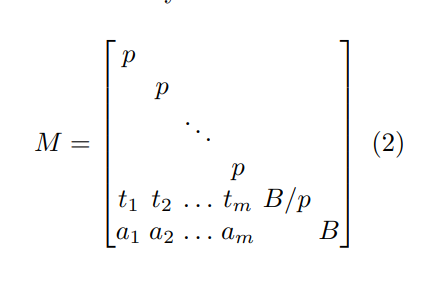L3HCTF2021
Table of Contents
阿巴阿巴,周末白天忙了一整天学校的事,晚上挂机跑了一晚还是没跑出来捏
EzECDSA #
This challenge use SECP256k1 curve to generate the generator ec system
we get 100 sets of signatures and the task.py tells us the low-8bits of K
leak:$kp = K;mod;256$
and question-44644 on stackexchange says its a problem of Elliptic Curve Digital Signature Algorithm with Partially Known Nonces
In there,known nonce is low-8bits
The idea is to convert the determination of a private key from biased k nonces in several ECDSA signatures into instances of the hidden number problem (HNP), and then solve the HNP as a reduction to the closest vector problem(CVP).
At least ,we kwon we can turn sequence S into a Linear structure
and the answer also tells us,how to turn the equation in a HNP
you can write k as
$k = a + 2^\ell b$
then
perfect,without any problem
Define
and you have
$xt = u + b$
construct sequence
Then,construct a matrix out of basis vectors:
which from this article

so,we should to find a beautiful B ,Then make
$S_T=B/p$
$S_U=B$
and if you are palying with a good luck
most likely, you’ll see the next-to-last entry of next-to-last row containing a dA or -dA
unfortunately,the lattice in paper seems not very efficient
and @BitLogiK gives a efficient way to make the boundary valid
His way of constructing denotation:
$T_i=2\cdot2^{\ell}\cdot \frac{R_i}{2^{\ell}\cdot S_i} ;mod;n$
$U_i=(2\cdot 2^{\ell}\cdot \frac{KP_i-H_i}{2^{\ell}\cdot S_i} ;mod;n)+n$
$Q’=2\cdot 2^{\ell}\cdot n$
$C_t=1$
$C_u=q$
new lattice looks like this:
then,the privacy will lay in next-to-last col
Obviously,I
def test_result(mat, target_pubkey, curve):
mod_n = ecdsa_lib.curve_n(curve)
for row in mat:
candidate = row[-2] % mod_n
if candidate > 0:
cand1 = candidate
cand2 = mod_n - candidate
if target_pubkey == ecdsa_lib.privkey_to_pubkey(cand1, curve):
return cand1
if target_pubkey == ecdsa_lib.privkey_to_pubkey(cand2, curve):
return cand2
return 0
solve #
recv data into a jsonfile and set lattice_attack.py options and get flag by hand
or copy others code to have a happy day 😀
#! python3
import icecream
import string
from icecream import *
from pwnlib.util.iters import mbruteforce
from pwn import *
from hashlib import sha256
from tqdm import tqdm
from rich.progress import track
from rich.traceback import install
install()
# -----------------------------------
table = string.ascii_letters+string.digits
from Crypto.Util.number import *
io = remote('0.0.0.0',23331)
def gopow():
s=io.recvuntil("XXXX+".encode("utf-8"))
s=io.recvuntil(")".encode("utf-8"))
suffix=s[:-1]
s=io.recvuntil("==".encode("utf-8"))
s=io.recvuntil("\n".encode("utf-8"))
cipher=s[1:-1].decode()
ic(cipher)
ic(suffix)
# ic("AAAA".encode() + suffix)
# ic(sha256("AAAA".encode() + suffix).hexdigest())
proof = mbruteforce(lambda x: sha256(x.encode() + suffix).hexdigest() == cipher, table, length=4, method='fixed')
ic(proof)
io.sendlineafter("Give me XXXX:", proof)
gopow()
pubkey=eval(io.recvline())
data={}
from tqdm import tqdm
from os import system
data["curve"]="SECP256K1"
data["public_key"]=[pubkey[0],pubkey[1]]
#data["message"]="0".encode("utf-8")
data["known_type"]="LSB"
data["known_bits"]=8
data["signatures"]=[]
for i in tqdm(range(100)):
io.recvuntil("ge:".encode("utf-8"))
io.sendline("0".encode("utf-8"))
io.recvuntil("r =".encode("utf-8"))
( ())
r=int(io.recvline())
io.recvuntil("s =".encode("utf-8"))
s=int(io.recvline())
io.recvuntil("kp =".encode("utf-8"))
kp=int(io.recvline())
io.recvuntil("hash =".encode("utf-8"))
hsh=int(io.recvline())
(data["signatures"]).append({"r":r,"s":s,"kp":kp,"hash":hsh})
f=open("data.json","w")
import json
f.write(json.dumps(data))
f.close()
system("python3 lattice_attack.py -f data.json")
d=eval(input("plz input the ans\n"))
io.sendline(str(d).encode("utf-8"))
io.interactive()

The curse of ECDSA nonces #
In the question-44644 on stackexchange we know how to solve HNP of bias nonce ecdsa
And Minerva: The curse of ECDSA nonces shows us the attack in detail

Obviously,the primitives is not what we should focus on

remove U to raise speed?
-
So mul $2^\ell$to T and U to
-
add a N to U
So,we make make an effort to make the boundary valid? :D